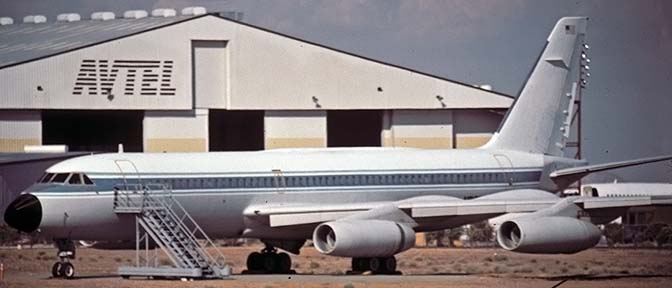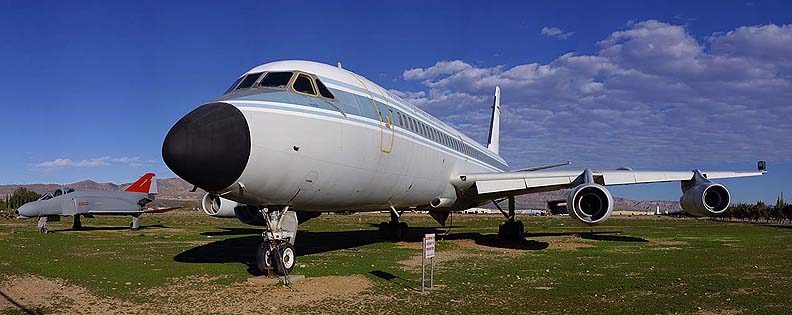
Convair 990 |
(Download a higher resolution picture by clicking on any
picture below.) 
The Convair 990 was produced in response to American Airlines requirement for a larger airliner than the Convair 880. Only 37 Cv-990s were manufactured from 1961 to 1963.
American Airlines was the primary U.S. customer for the Cv-990. Swissair, VARIG, and Garuda Indonesian Airways were among the early foreign operators of the Cv-990. Scandanavian Airlines System ordered several Cv-990s, but did not take up most of their orders. Some Cv-990s found their way to service in South America with Aerolineas Peruanas SA.
The last airworthy Convair 990 is in danger of being scrapped at El Paso International Airport, Texas. Check out the situation at the Convair 990 Preservation Project web site.
| Convair 880 | Convair 990 | Boeing 707-120 | Douglas DC-8 | |
| Wing Span | 120 ft. | 120 ft. | 130 ft. 10 in. | 142 ft. 5 in. |
| Length | 129 ft. 4 in. | 139 ft. 5 in. | 144 ft. 6 in. | 150 ft. 6 in. |
| Passengers | 88 - 110 | 96 - 121 | 110 - 189 | 105 - 173 |
| Maximum Cruise Speed | 615 mph | 610 mph | 585 mph | 579 mph |
Following their retirement from airline service, NASA made use of several Cv-990s as airborne observation platforms and research aircraft.
 Convair 990, N5617 at NAS Moffett
in August 1975, shortly after its acquisition by NASA. Its
Convair airframe number is 30-10-29. It was delivered to American
Airlines in May 1962 as N5617. Modern Air Transport purchased it
in 1968. NASA acquired it for use at Ames Research Center in May
1975 and registered it as N713NA. NASA later re-registered it as
N710NA.
Convair 990, N5617 at NAS Moffett
in August 1975, shortly after its acquisition by NASA. Its
Convair airframe number is 30-10-29. It was delivered to American
Airlines in May 1962 as N5617. Modern Air Transport purchased it
in 1968. NASA acquired it for use at Ames Research Center in May
1975 and registered it as N713NA. NASA later re-registered it as
N710NA.
 The fuselage of Convair 990, N7876
in use by NASA at NAS Moffett in August 1975. Its Convair
airframe number is 30-10-4. Initially it served Convair as a
Cv-990 demonstrator, registered as N5604G. It was delivered to
Garuda Indonesian Airways as PK-GJB, Sriwijaja on October 23,
1963. It was purchased by California Airmotive Corporation in
June 1973 and registered as N7876. It crashed on the Jakarta Guam
leg of its delivery flight to the U.S. on September 10, 1973.
Under the nose someone has spray painted Robinson Caruso NAS
(sic).
The fuselage of Convair 990, N7876
in use by NASA at NAS Moffett in August 1975. Its Convair
airframe number is 30-10-4. Initially it served Convair as a
Cv-990 demonstrator, registered as N5604G. It was delivered to
Garuda Indonesian Airways as PK-GJB, Sriwijaja on October 23,
1963. It was purchased by California Airmotive Corporation in
June 1973 and registered as N7876. It crashed on the Jakarta Guam
leg of its delivery flight to the U.S. on September 10, 1973.
Under the nose someone has spray painted Robinson Caruso NAS
(sic).
Link to the Aviation Safety Network's account of the crash of N7876 at Guam.
 Convair 990, N990AB at Mojave,
California on March 27, 1980. Its Convair airframe number is
30-10-2. It was the second Convair 990 built and flew for the
first time on January 30, 1961. It served Convair as a Cv-990
demonstrator, registered as N5602G. It was delivered to Garrett
Airesearch on July 8, 1964 which leased it to Aerolineas Peruanas
SA (APSA) on February 1, 1965. F. B. Ayer and Associates
purchased it from APSA on August 21, 1973. It was stored at
Tucson IAP, Arizona until 1980, when it was sold to Gulfstream
American Corporation and flown to Mojave.
Convair 990, N990AB at Mojave,
California on March 27, 1980. Its Convair airframe number is
30-10-2. It was the second Convair 990 built and flew for the
first time on January 30, 1961. It served Convair as a Cv-990
demonstrator, registered as N5602G. It was delivered to Garrett
Airesearch on July 8, 1964 which leased it to Aerolineas Peruanas
SA (APSA) on February 1, 1965. F. B. Ayer and Associates
purchased it from APSA on August 21, 1973. It was stored at
Tucson IAP, Arizona until 1980, when it was sold to Gulfstream
American Corporation and flown to Mojave.
 Convair 990, N990AB at Mojave,
California on May 3, 1980. Gulfstream American has already pulled
the engines. It is still sitting in the desert sun at Mojave.
Convair 990, N990AB at Mojave,
California on May 3, 1980. Gulfstream American has already pulled
the engines. It is still sitting in the desert sun at Mojave.
 Convair 990, N990AC at Marana,
Arizona on December 30, 1981. Its Convair airframe number is
30-10-5. It was ordered by Scandanavian Airlines System as OY-KVA
but not taken up. Convair registered it as N8484H before
delivering it to APSA on November 13, 1963. APSA registered it as
OB-OAG-728 and later OB-R-728. F. B. Ayer and Associates
purchased it from APSA in August 1973, re-registered it as
N990AC, and sold it to General Dynamics Corporation, which flew
it to Marana, Arizona and parked it. It was purchased by NASA in
May 1982.
Convair 990, N990AC at Marana,
Arizona on December 30, 1981. Its Convair airframe number is
30-10-5. It was ordered by Scandanavian Airlines System as OY-KVA
but not taken up. Convair registered it as N8484H before
delivering it to APSA on November 13, 1963. APSA registered it as
OB-OAG-728 and later OB-R-728. F. B. Ayer and Associates
purchased it from APSA in August 1973, re-registered it as
N990AC, and sold it to General Dynamics Corporation, which flew
it to Marana, Arizona and parked it. It was purchased by NASA in
May 1982.
 Convair 990 N712NA Galileo II at
NAS Moffett on July 3, 1983. Its Convair airframe number is
30-10-37. It was the penultimate Cv-990. It was delivered to
Garuda Indonesian Airways as PK-GJC, Majapakit on September 3,
1963. It was purchased by California Airmotive Corporation in
June 1973 and registered as N7878. This Cv-990 survived its
delivery flight to the U.S.
Convair 990 N712NA Galileo II at
NAS Moffett on July 3, 1983. Its Convair airframe number is
30-10-37. It was the penultimate Cv-990. It was delivered to
Garuda Indonesian Airways as PK-GJC, Majapakit on September 3,
1963. It was purchased by California Airmotive Corporation in
June 1973 and registered as N7878. This Cv-990 survived its
delivery flight to the U.S.
The original Galileo N711NA was lost in a mid-air collision with a P-3 Orion on approach to NAS Moffett on April 12, 1973. NASA acquired N712NA to replace Galileo on September 4, 1973.
Link to VP-47's account of the crash of Galileo, N711NA at NAS Moffett.
Following an aborted take-off at March AFB, California on July 17, 1985, Galileo II caught fire and burned.
Link to the Aviation Safety Network's account of the burning of Galileo II, N712NA at March AFB.
Note that the slipper tanks on N712NA are painted black while they are painted gray on N710NA in the background.
 Convair 990, N712NA Galileo II and
N710NA at NAS Moffett on July 3, 1983. N710NA was used at the
Ames Research Center until 1983 when it was withdrawn from use.
It was stored at Marana, Arizona until it was refurbished in 1989
for use at the Dryden FRC, where it was registered as N810NA.
After serving as the Landing Systems Research Aircraft in 1993
and 1994, it was retired to Mojave.
Convair 990, N712NA Galileo II and
N710NA at NAS Moffett on July 3, 1983. N710NA was used at the
Ames Research Center until 1983 when it was withdrawn from use.
It was stored at Marana, Arizona until it was refurbished in 1989
for use at the Dryden FRC, where it was registered as N810NA.
After serving as the Landing Systems Research Aircraft in 1993
and 1994, it was retired to Mojave.
Link to NASA Dryden's Landing Systems Research Aircraft Fact Sheet.
Link to NASA Dryden's Landing Systems Research Aircraft Photo Gallery.
 Convair 990 N712NA Galileo II at
NAS Moffett on July 3, 1983.
Convair 990 N712NA Galileo II at
NAS Moffett on July 3, 1983.
 The former Landing Systems Research
Aircraft Convair 990 N810NA in storage at Mojave on July 27,
1997.
The former Landing Systems Research
Aircraft Convair 990 N810NA in storage at Mojave on July 27,
1997.
 Seen here on September 10, 2001,
Convair 990, N810NA has been moved to a position adjacent to the
main entrance to the airport from Highway 58.
Seen here on September 10, 2001,
Convair 990, N810NA has been moved to a position adjacent to the
main entrance to the airport from Highway 58.
 Convair Cv-990, N990AB at Mojave on
September 10, 2001.
Convair Cv-990, N990AB at Mojave on
September 10, 2001.
 The interior of N990AB is still in
fairly good condition. This photo of the cockpit was taken during
the summer of 2001 by Alan Radecki.
The interior of N990AB is still in
fairly good condition. This photo of the cockpit was taken during
the summer of 2001 by Alan Radecki.
 The seats in N990AB are still
intact as seen in this photo taken during the summer of 2001 by
Alan Radecki.
The seats in N990AB are still
intact as seen in this photo taken during the summer of 2001 by
Alan Radecki.
 Convair 990 N810NA NASA Landing Systems Research Aircraft displayed adjacent to the main entrance to the Mojave Airport on December 6, 2008. It was used at the NASA Ames Research Center until 1983 when it was withdrawn from use. It was stored at Marana, Arizona until it was refurbished in 1989 for use at the Dryden FRC. After serving as the Landing Systems Research Aircraft in 1993 and 1994, it was retired to the Mojave Airport.
Convair 990 N810NA NASA Landing Systems Research Aircraft displayed adjacent to the main entrance to the Mojave Airport on December 6, 2008. It was used at the NASA Ames Research Center until 1983 when it was withdrawn from use. It was stored at Marana, Arizona until it was refurbished in 1989 for use at the Dryden FRC. After serving as the Landing Systems Research Aircraft in 1993 and 1994, it was retired to the Mojave Airport.